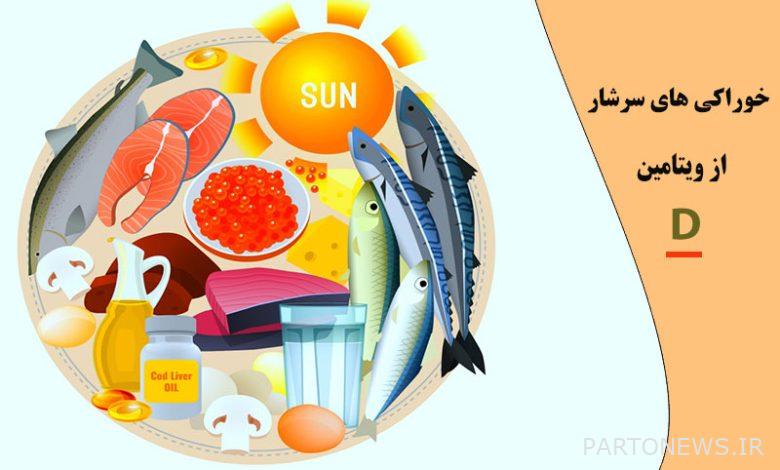What are the dietary sources of vitamin D?

Vitamin D is one of the few vitamins that the human body can make and if the human skin is exposed to direct sunlight, it will be easily produced in the body. We can not say that vitamin D is found in many foods. So if each of us is not exposed to enough sunlight and does not use food sources of vitamin D, it is unlikely that we are deficient in vitamin D. In this case, taking vitamin D tablets becomes necessary. If you want to know which food has the highest amount of vitamin D, stay tuned for the rest of this article.
What we read in this article
Benefits of Vitamin D for the body
Vitamin D is an amazing vitamin that the world of science is discovering one of its new benefits every day. You may have heard that the role of vitamin D in coronavirus is currently a hot topic in coronary heart disease medications. The most important benefits of vitamin D can be summarized as follows:
- Improving bone and tooth health
- Support the immune system, brain and nervous system
- Regulate blood insulin levels and control diabetes
- Protect lung function and cardiovascular health
Vitamin D deficiency can be linked to cardiovascular disease, autoimmune diseases, neurological diseases, various infections, pregnancy problems, and some cancers such as breast, prostate, and colon cancers.
Some studies have shown that most people who are hospitalized for severe Covid-19 have low levels of vitamin D in their bodies. Accordingly, vitamin D may play a preventive role in coronary heart disease; However, research in this area is not yet complete.
Food sources of vitamin D.
Vitamin D acts as a powerful antioxidant in the body and several studies have confirmed the important role of this nutrient in preventing oxidative stress. This property of vitamin D helps to prevent the occurrence of chronic diseases such as diabetes, cardiovascular disease and kidney disease. The best dietary sources of vitamin D include:
Fatty fish are the best sources of vitamin D.
Oils from fish, as well as fish that are high in beneficial fats, are the richest sources of vitamin D, including:
Fish liver oil
This oil in each teaspoon contains 450 IU (international unit) of vitamin D, which is 75% of the recommended daily amount for each person. Cod liver oil also contains other nutrients such as omega-3s and vitamin A.
Herring and swordfish
Each herring fillet contains 306 international units of vitamin D, which provides 51% of an adult’s daily needs. Herring is a small fish that is used raw, canned and smoked all over the world. Each piece of swordfish meets 117% of each person’s daily needs, which is a very significant amount.
Salmon from food sources of vitamin D.
One of the best sources of vitamin D is definitely salmon. 100 grams of salmon can meet 66% of each person’s daily needs. Of course, farmed salmon may not be as rich in vitamin D as regular salmon, but they are still a good source of this nutrient.
Canned tuna
One of the easiest ways to enjoy fish is to use it in canned form. 100 grams of canned tuna provides 34% of the daily requirement and is also an ideal source of niacin and vitamin K. Eating tuna up to 170 grams per week is safe, but you should be aware that unfortunately this food contains large amounts of mercury, and if consumed in large quantities, the accumulation of toxins in the body will cause serious health problems.
The best time to get vitamin D through sunlight is in the summer from 10 am to 2 pm.
Mushrooms are the only plant source of vitamin D.
Vegetarians who do not eat fish can use mushrooms as one of the best sources of vitamin D instead. There are several types of fungi, including high in vitamin D. 50 grams of Mytakeh mushrooms and 50 grams of Shitakeh mushrooms provide 94% and 12% of the body’s daily requirement of this vitamin, respectively. Fungi that are exposed to sunlight can also contain large amounts of vitamin D.

Note that there are two types of vitamin D: D2 and D3. Mushrooms contain only vitamin D2, while the animal sources we introduced to you contain vitamin D3. Vitamin D2 helps increase the level of vitamin D in the blood but may not be as effective as vitamin D3.
Egg yolks are the richest source of vitamin D.
While most of the protein in eggs is found in egg whites, fats, vitamins and minerals are mostly found in egg yolks. 2 large eggs can meet 15% of the daily requirement of vitamin D. Of course, this is an approximate amount because the level of vitamin D in egg yolks depends on the amount of exposure of the chicken to sunlight and the food that the chicken has fed. According to these interpretations, chickens raised on farms and exposed to sunlight have more vitamin D-rich eggs than other chickens.

Foods fortified with vitamin D.
Today, with the advancement of human science and knowledge, vitamin D is added to many foods to increase their nutritional value. Here are some examples of these foods:
Cow’s milk and soy milk
The most common milk consumed in various communities is cow’s milk, which contains many nutrients, including calcium. In many countries, cow’s milk is fortified with vitamin D, so that each cup of it provides 15 to 22 percent of the body’s daily requirement of vitamin D.
Vegetarians are more likely than others to develop symptoms of vitamin D deficiency. These people can use plant-based milks such as soy milk to compensate for the deficiency of this vitamin. This milk is usually enriched with all the nutrients in cow’s milk. 1 cup of soy milk eliminates 13 to 15% of the daily requirement of vitamin D.

Orange juice enriched with vitamin D.
Many people around the world are allergic to lactose and milk and cannot use it. For this reason, fruits such as orange juice, which are also popular, are fortified with vitamin D for the use of these people.
Cereals fortified with vitamin D.
Another great source of vitamin D is cereals, which are fortified with this vitamin. These grains are also more suitable for vegetarians, and although they do not have a high content of vitamin D, they can still be a good way to get this nutrient to the body.
Plant sources of vitamin D.
It is better for vegetarians to use mushrooms, egg yolks and foods fortified with vitamin D, which we introduced in the previous section, to provide the vitamin D their body needs. Yogurt and cheese will also be ideal if enriched with vitamin D. Flaxseed, forty plants, sap, peach and apricot leaves, sheep and beef curd also contain adequate amounts of vitamin D.
What fruits have vitamin D?
Fruits do not contain vitamin D3 because it is found in animal sources. However, as we have explained, some juices, such as orange juice, are fortified with vitamin D and are available in the market that can be used.
Symptoms of vitamin D deficiency
If you experience the following symptoms, it is not at all unlikely that you are deficient in vitamin D:
- Colds and persistent infections
- Fatigue
- Bone and back pain
- Feeling sick
- Delay in wound healing
- hair loss
- Muscular pain

Vitamin D tablets are the best source of vitamin D.
In cases of vitamin D deficiency, be sure to use a vitamin D supplement or tablet. In some cases, your doctor may prescribe vitamin D injections. Vitamin D tablets in doses of 1000, 2000, 400, 50,000 and… are easily found in the market, but the exact amount should be determined by a doctor because this vitamin is fat-soluble and if used too much, it accumulates in the body. It will be accompanied by undesirable side effects.
The best time to take vitamin D is with meals and along with foods that contain beneficial fats. Note that vitamin D significantly increases the absorption of calcium in the body.
Treatment of vitamin D deficiency in traditional medicine
Air pollution is one of the causes that interferes with the absorption of vitamin D and causes many people to be deficient in this nutrient. Traditional medicine has the following recommendations for providing the body with vitamin D:
- Consume ground red flax seeds with local yogurt and thyme
- Sweat or alfalfa with honey
- Sweat of Baba Adam and sweat of Mukhlesa
- Forty plants with milk
- Peach and apricot leaves
Final speech
In this article, we have introduced the best food sources of vitamin D to you. This vitamin is not present in many foods and the best source of it can be considered sunlight. In today’s world, many people need to take vitamin D supplements as a supplement to make up for the lack of this nutrient in their body. However, it is better to use vitamin D tablets with your doctor’s advice.
Please rate this article
[مجموع: ۲ میانگین: ۵]


